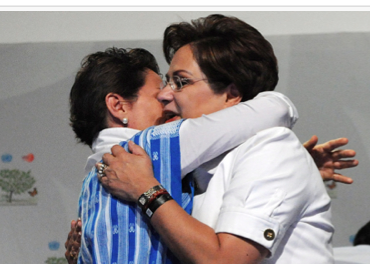The UN Climate Change Conference in Cancun, Mexico, concluded on 11 December 2010, with the adoption of the “Cancun Agreements,” which include decisions under both the Convention and Protocol negotiating tracks, and contain provisions on adaptation, REDD+, technology, mitigation and finance.
 11 December 2010: The UN Climate Change Conference in Cancun, which took place from 29 November-11 December 2010, concluded with agreement on a package of decisions. The Cancun Agreements include decisions under both the Convention and Protocol negotiating tracks, and contain provisions on adaptation, REDD+, technology, mitigation and finance.
11 December 2010: The UN Climate Change Conference in Cancun, which took place from 29 November-11 December 2010, concluded with agreement on a package of decisions. The Cancun Agreements include decisions under both the Convention and Protocol negotiating tracks, and contain provisions on adaptation, REDD+, technology, mitigation and finance.
The Conference included the 16th session of the Conference of the Parties (COP 16) to the UNFCCC and the sixth session of the Conference of the Parties serving as the meeting of the Parties to the Kyoto Protocol (COP/MOP 6). It also comprised the 33rd sessions of the Subsidiary Bodies, the 15th session of the Ad Hoc Working Group on Further Commitments for Annex I Parties under the Kyoto Protocol (AWG-KP 15), and the 13th session of the Ad Hoc Working Group on Long-term Cooperative Action under the UNFCCC (AWG-LCA 13). These events drew almost 12,000 participants, including almost 5200 government officials, 5400 representatives of UN bodies and agencies, intergovernmental organizations and non-governmental organizations, and 1270 accredited members of the press.
The focus in Cancun was on a two-track negotiating process aiming to enhance long-term cooperation under the Convention and the Protocol. In the lead-up to the conference, several matters were widely identified as areas where a balanced “package” of outcomes could be agreed. These issues included: mitigation; adaptation; financing; technology; reducing emissions from deforestation and forest degradation in developing countries, including conservation, sustainable forest management and enhancement of forest carbon stocks (REDD+); and monitoring, reporting and verification (MRV) and international consultation and analysis (ICA). Negotiations on these key issues took place throughout the two-week meeting, with parties meeting extensively in plenary, contact groups, informal consultations and bilateral meetings. During the second week, ministers from developed and developing countries were “paired” in an attempt to facilitate negotiations on the main issues. These negotiations continued all week, with regular informal “stocktaking” plenary sessions, which were held to maintain a degree of transparency and keep all participants informed about progress.
By early Saturday morning, parties had finalized the “Cancun Agreements.” The Agreements include decisions under both the Convention and Protocol negotiating tracks, and contain provisions on adaptation, REDD+, technology, mitigation and finance. While the substantive outcome was viewed by many as far from perfect and Bolivia went as far as to oppose the adoption of the Agreements, most participants were satisfied with the outcome and indicated that it restored their confidence in the UNFCCC process. However, in spite of the sense of relief felt by many at securing a result, most participants acknowledged that it was a relatively small step in combating climate change.
Commenting on the adoption of the Cancun Agreements, UNFCCC Executive Secretary Christiana Figueres recognized that “it is not what is ultimately required but it is the essential foundation on which to build greater, collective action.” She added that “The beacon of hope has been reignited and faith in the multilateral climate change process to deliver results has been restored.”[UNFCCC Press Release] [IISD RS Coverage]